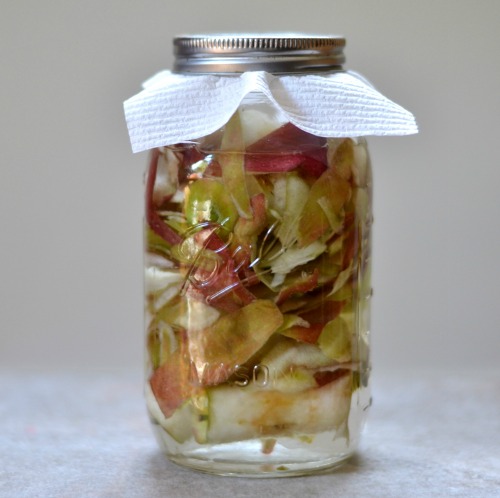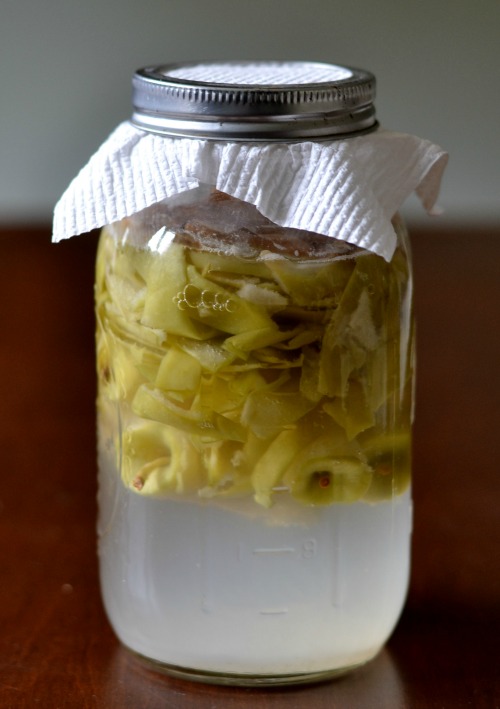Apple cider vinegar is a valuable ingredient for good health, and it’s easy to make at home. I don’t enjoy peeling and coring apple after apple to make a pie or a cobbler, but I do love being able to make something valuable out of the scraps. Apple cider vinegar helps to fight inflammation and digestive problems, and it also has a detoxifying effect. In addition, many people use it as a household cleaner and a facial cleanser.
Once you’ve peeled and cored the apples for whatever yummy treat you’re making, you’ve done most of the work. Follow this simple, step-by-step tutorial to make your own batch of apple cider vinegar. Adapted from this recipe for apple cider vinegar, I substituted sugar for the honey. Either sweetener will work to ferment the cider vinegar, but sugar makes things move a bit more quickly.
Step One: Prepare the Ingredients
Place the peels and cores of 6-8 apples (ideally organic) into a quart-sized mason jar. Pour water into the jar to cover the scraps by one inch. Add one tablespoon of sugar per cup of water.
Step Two: Soak the Apple Scraps
Place a paper towel and a canning ring on top of the jar, and put it in a dark cabinet. Warmer temperatures will move things along more quickly than cooler ones. Leave the jar undisturbed for two weeks.
Step Three: Strain and Wait
After two weeks, strain the contents of the jar through a fine-mesh strainer. Discard the solids, and return the liquid to the jar. It should smell like wine. Cover again with a paper towel and canning ring, and return the jar to the cabinet for another two weeks.
Step Four: Wait Some More
After this second period of two weeks, remove the jar from the cabinet and examine it. You’ll notice sediment on the bottom of the jar, which is normal. If your cabinet is quite warm, it may have turned to vinegar by now. Smell it and see if it smells more like wine or vinegar. You can also taste it to see if it tastes like strong vinegar yet. If it doesn’t seem ready, return it to the cabinet and check on it weekly until it has darkened a bit and tastes like vinegar. In my cool New England climate, it typically takes four to six weeks in this second phase before I have vinegar.

The left jar shows the vinegar after 2 weeks. The right jar has been sitting for several more weeks.
Step Five: Transfer to Storage
When your vinegar is as strong as you’d like it to be, strain it through several layers of cheese cloth or butter muslin to remove the sediment. I like to store it in a mason jar with a metal canning top.
Good luck, and let me know if you try it!












That sounds really interesting, since my garden is now filled with fresh apples I will absolutely try this recipe, thanks.
You’re lucky to have a garden full of apples! I hope the recipe works well for you.
I always have apple cider vinegar in my cabinet, but never knew it was so easy to make. Thanks!
I always take a couple teaspoons full of the apple cider vinegar if I am going to eat a heavy meal. It works wonders!
Thanks, Annette! It works wonders, doesn’t it?
Wow! Very cool! I didn’t realize was so easy to make, I’m definitely going to do this! Thank you 🙂
Thanks, Shawn-Marie. I hope it works well for you.
hello
I have a question. Before storing the ACV is it necessary to put in small amount of salt? to stop the further fermantaton?thanks
I don’t add any salt to my apple cider vinegar. There are many different recipes and approaches out there for homemade ACV, and in my research I haven’t seen adding salt as part of the process.
I’m at the two week point. There was mold on the tops of my apples, mostly those that were out of the water. I tried to skim them out without getting them in the water, but I’m not sure if that matters. Is the batch contaminated now?
Emily, I haven’t gotten mold on any of my batches when I’ve made this vinegar, but I know it isn’t uncommon. Don’t worry about it. However, if the final product doesn’t seem right, you can always use it as a household cleaner.
Good idea! Then you aren’t wasting anything. Smart.
I was so excited to try this!! We go through a lot of apple cider vinegar in our home. 🙂 I have a question. I’m at the part where you strain out the liquid from the peels and cores. I also had a little bit of mold on top, which I wasn’t too concerned about. But also, the liquid is almost like a thick syrup. Is that normal? Is it ok? Thanks so much! 🙂
I’m glad you’re trying this, Clara! My vinegar doesn’t come out thick, but I’ve heard from others that this isn’t uncommon. Apples are naturally high in pectin, which is the thickener that makes jam thick. I’m guessing your vinegar will be fine once it’s done, but use your judgment. If it doesn’t taste right, it can be used as a cleaner. Good luck, and let us know how it turns out.
Could the thickness in the solution be the “mother” that is healthy & good to have for using to make more vinegar with a lot quicker?
Dane, that’s possible, but the mother is typically described as a jelly-like “glob” in one spot. It does help speed up the process in future batches.
How long is this good for?
Angela, I’ve kept this for up to a year and it’s still been good. I’m guessing it would last well beyond that period of time, but I haven’t tried it.
Can i brew this next to my kombucha or will the gasses interfere with each other?
Erin, I haven’t tried brewing kombucha yet, so I can’t say for sure.
I’ve made apple cider vinegar according to your recipe 3 times w/no problems!
This third time after I’ve strained out the apple peels, there’s mold growing on top of my vinegar! Did I do something wrong? Should I throw it out?
I see this is an older post, so I’m not sure if you’ll see this, but after two weeks mine smells like yeast. Normal? I’ve got in back in the cabinet for another two weeks and we’ll see how it is!
I don’t think it’s a problem, Jen. Keep checking on it, and I think it will eventually smell like vinegar. If you’re in doubt after the appointed time, you can always use it for a cleaner. Good luck, and let us know how it turns out!
My attempt to make the ACV: I totally forgot to check it. Must have been a month in my daughter’s linen closet. Today I took it out and it was totally covered with furry gray mold. Using a slotted spoon, I cleared out all the apple parts. I am sure some of the mold must have gotten in the vinegar. It smells pretty good actually, kind of sweet. The color is like your example but no real sediment. Do I go ahead and strain it or wait? Thanks.
I would continue with the process. You can always use it as a cleaner if you’re not comfortable with the final result. Let us know how it turns out!
I see you said the vinegar should last a year. We have almost a dozen apple trees. That will make a lot of vinegar. For long term storage does it need to be canned? I am quite the novice when it comes to food preservation, so I don’t know if vinegar can even spoil. Thanks for sharing this recipe.
I’d make sure the peels were from organic apples or you’re defeating the purpose. At least no pesticides used on them